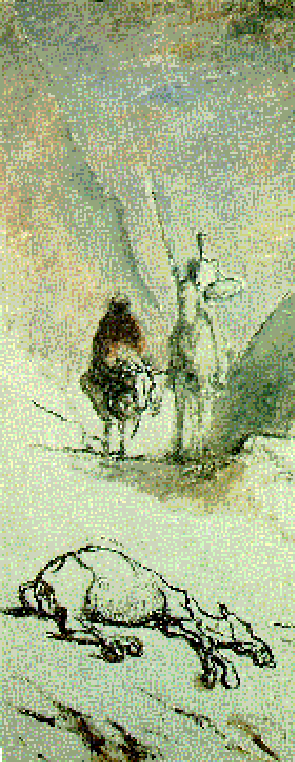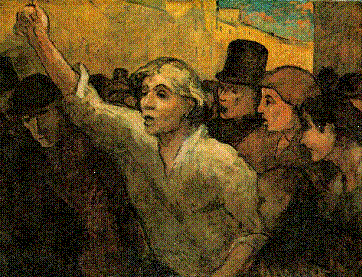
The Phillips Collection
March 2000
 While visiting Washington D.C. to make presentations to various government agencies I found myself with almost a whole day off on my 60th birthday on March 2, 2000. With the spare time I visited the Phillips Collection, which touts itself as America's first museum of modern art, containing works from the early nineteenth century to present. Among the collection are impressive works by Daumier, Renoir, Manet, Monet, Delecroix, Van Gogh, Picasso, Bonnard, Carot, Pizaro, Rothko, DeKooning, and so on plus many recent and less well known artists.
While visiting Washington D.C. to make presentations to various government agencies I found myself with almost a whole day off on my 60th birthday on March 2, 2000. With the spare time I visited the Phillips Collection, which touts itself as America's first museum of modern art, containing works from the early nineteenth century to present. Among the collection are impressive works by Daumier, Renoir, Manet, Monet, Delecroix, Van Gogh, Picasso, Bonnard, Carot, Pizaro, Rothko, DeKooning, and so on plus many recent and less well known artists.
Specialty Museums such as the Phillips Collection are much easier for me to deal with, since I find it difficult to switch between two drastically different art styles. I enjoy, even more, special exhibits that concentrate on a single artist. Consequently, I was delighted to discover that the Phillips collection was showing (February 19 to May 14) the most extensive collection of works by Honore Daumier (1808-1879) ever assembled, containing over 270 works by the artist, including drawings, paintings, and sculpture. I was even more delighted because Honore Daumier was a master at gestural and modeled drawings, drawing styles that I am attempting in an ongoing art class without sterling success. Seeing many original works by a master gave me a renewed inspiration and perhaps new understanding of the power and meaning of these art styles.
My usual modus operandus for museums is to spend most of the time concentrating on the special exhibit, followed by a rather quick walk through of the rest of the museum, since I would usually be too saturated to really appreciate the rest of the museum. I used a variation of this method on the Phillips Collection, spending a few minutes meditating on a Mark Rothco, observing wall space wasted on De Kooning and Miro and moving on to Daumier.
Daumier started his career with cartoons and caricatures, working for a news journal in Paris. He is one of the early artists to purposely use abstraction, gesture, modeling and stylizing to strengthen meaning and emotion in the political statement made by a work of art. For example, many of his cartoons ridiculed King Louis by depicting him in the shape of a pear a derogatory symbol known to all Frenchmen. At one point Daumier was jailed for six months for his poignant political statements using art. There is rarely any question about the main theme of a Daumier. He was the "people's artist" and a commoner with no training could interpret and, moreover, feel his message. His work is recognized as influential on many artists to follow, such as Degas, Van Gogh, Monet, and Picasso. (Degas had nearly a hundred of Daumier's works in his collection of art.)
Later Daumier concentrated on painting and produced some extremely powerful works such as "The Uprising", my favorite (most people's favorite, apparently) in the exhibit, an oil on canvas, 34.5 by 44.5. There is little doubt what is underway in this picture. A young peasant man surrounded by peasants gestures with thrusted fist and a shouting face. The picture explodes with near riotous movement as the crowd thrusts forward.
Better examples of modeled drawings are "The Family", water color, chalk, and pencil on paper, a small 6.5 by 7.5 inches piece (many of Daumier's works were small) and "Man on a Rope", oil on canvas, 111 by 75 cm. Daumier was clearly ahead of his time. Some of his works look more like what Picasso was doing seventy five years later. In fact, Daumier did many drawings and Paintings of Don Quixote that could well be fore runners of a more famous Don Quixote by Picasso. In Daumier's "La Parade" one can see a forerunner of Munch's "The Scream".
After seeing the original works of Daumier in such quantity and variety I finally "got it". A successful gestural or modeled drawing captures and conveys motion, emotion, and energy with greater intensity than a realistic drawing. It represents a distillation of the energy and emotion from a realistic scene leading to concentrated, almost pure information, thus reducing the distraction that might have been caused by the physical features of the scene itself. Moreover, the emotion and energy can be easily amplified in such a representation by exaggeration. I had been trying to draw the "thing" instead of the emotion and energy associated with "the thing". Seeing his work and reading his history provided the insight I needed. Unlike an abstraction, where the viewer may have to reason out the meaning, gestural drawings hit the viewer in the face with a message that is not likely to be misinterpreted. Daumier worked for a political news paper. He developed and exploited this style because it was his job to galvanize and enrage people efficiently with art, and he succeeded very well in doing just that.

After spending a few hours covering three floors of work by Daumier, I wandered into the remaining parts of the museum, by this time being almost totally saturated with art. It happened that I began this on the third floor, not really knowing what to expect as I walked along a narrow hall that connects the two parts of the museum. In the first room I felt a small surge of energy with the immediate recognition of a dozen impressionist paintings including Monet, Van Gogh, and Picasso. Feeling some special energy behind me I turned around to look and almost went into cardiac arrest at what I saw. I was totally surprised and elated to see Renoir's "Luncheon of the Boating Party", probably Renoir's greatest work and a work I have admired only in books for many years. Having seen the real piece, I admire it much more than ever. For my own enjoyment this painting overshadows every painting in the collection, maybe every painting in Washington D.C. Phillips had the great foresight to purchase the Renoir in 1923 for $125,000, which probably was an enormous amount of money to pay for a painting at the time.
I modified my modus operandus to a quick shuffle through the rest of the museum to return to the Renoir and stay with it until they closed the museum and kicked me out.